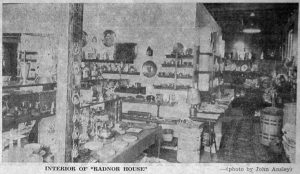 In the left foreground of the picture (right) is shown one of the square upright posts of the one-time feed and grain store in Radnor, as carefully preserved as were the ceiling beams shown in last week’s picture. Its rough exterior shows that it was hand-hewn when it was put in place some 80 years ago, and is one of the picturesque reminders of the past in the remodelled interior of the present “Radnor House” on Belrose lane.
In the left foreground of the picture (right) is shown one of the square upright posts of the one-time feed and grain store in Radnor, as carefully preserved as were the ceiling beams shown in last week’s picture. Its rough exterior shows that it was hand-hewn when it was put in place some 80 years ago, and is one of the picturesque reminders of the past in the remodelled interior of the present “Radnor House” on Belrose lane.
Mr. and Mrs. Paul Thomas, owners of Radnor House, designate this as the “West Room”, to distinguish it from the “Green Room”, which was part of the original structure. Noteworthy in the latter is the number of heavy hand-hewn ceiling beams held together by tongue and groove joints and wooden pins, which have been in place since the stable area was built in the 1700’s.
Today’s picture shows not only the interior of the “West Room”, but also the long hallway to the right of it, previously described.
We noted in last week’s column that the foundation of this building was of dry stone, in which one of the original stone ties from the old Philadelphia and Columbia Railroad had been used. Since then an interesting bit of information in regard to these ties has come to light.
Original these stone blocks, which were so heavy that four men were required to lift them, were hewn by inmates of “Sing Sing” prison. When these prisoners were unable to produce them rapidly enough to keep up with construction of the railroad, wooden ties were substituted. These were to be used until production could catch up with demand, but they were such satisfactory substitutes for the heavy stone that they were retained. When the Pennsylvania Railroad acquired the Philadelphia and Columbia Railroad in 1857, much of the original track was relocated. The heavy stone ties then discarded are still to be found here and there along the Main Line, where they have been put to various uses.
In July 1952, after Mr. and Mrs. Thomas bought the old stable and feed store from L. Rodman Page and William B. Thompson, they traced ownership of the tract back to August 30, 1685. According to Smith’s Patent Atlas, a grant of land by the government was made to one David Davis. By January, 1686, Davis had deeded the property to William Thomas. The latter kept it for 21 years, and in April, 1707, deeded it to Owen Lewis. Then in rapid succession it passed to Evan Jones and to Richard Orme.
In 1734, the first Morgan came into possession of the property – the John Morgan from whom Morgan’s Corner, now Radnor, took its name. Various others of the Morgan family owned the property on King of Prussia road until 1812, when it was deeded to Elisha Moore, who five years later sold it to Abner Lewis. By 1842 “a tavern and tenements” were mentioned in the deed of sale as well as houses, out-buildings, barn and stable. By 1854 “15 1/4 acres and one porch” were sold by William M. Lowman and Sarah, his wife, of New York, to Isaac Palmer. This deed mentions “a public house”, and also the Philadelphia and Columbia Railroad, which apparently ran through the property at that time. (Ed. Note: The tracks ran alongside the oldest building of what is not the Radnor Inn.)
By 1878 W.W. Montgomery and Theodore D. Rand had acquired “a dwelling house, formerly a hotel, store and other buildings.” This property bordered the Pennsylvania Railroad and was so described. Very soon the Montgomery and Rand families had sold at least part of the property to Theodore F. Ramsay. Other families who came into ownership after that were the Yarnalls, the Dillins, the Torpeys and the Morrisons, bringing the ownership up to 1952, when Charles Morrison sold his interest to L. Rodman Page and William B. Thompson. Among these earlier names are many who have been connected with the settlement and development of Radnor.
Three of the old deeds, their ink faded with time, are in possession of Mr. Thomas. One of these interesting documents dates back to 1878, another to 1879 and the third to 1874.
(To Be Continued)
